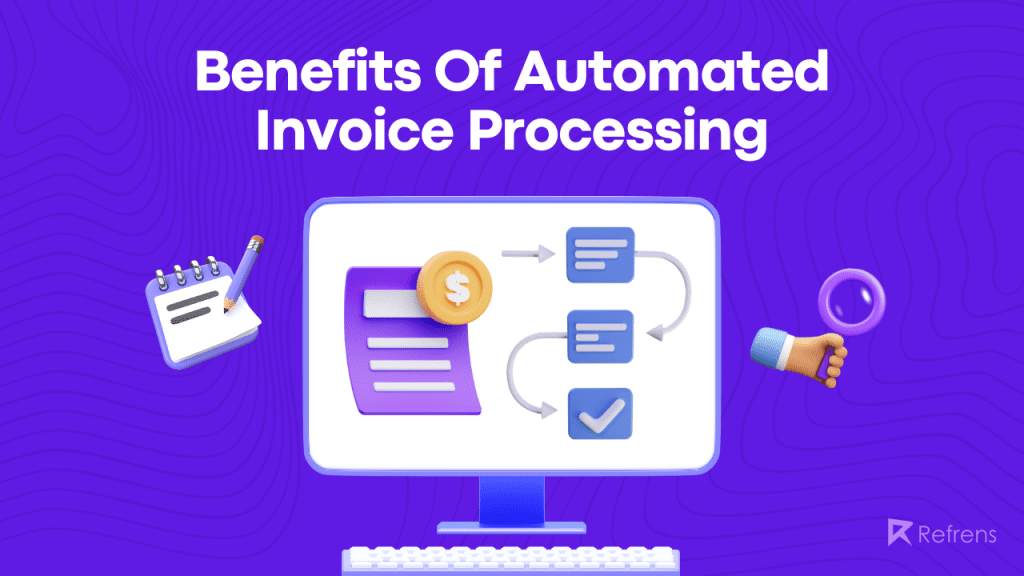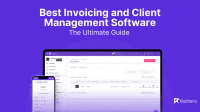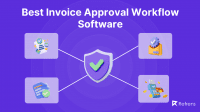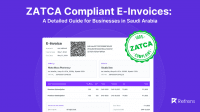The use of invoice automation is becoming increasingly popular in businesses, as it provides a variety of advantages that help to streamline the invoicing process.
Automated invoicing is incredibly beneficial for businesses. According to surveys, automated invoices have a much higher on-time payment rate than manual ones with 42% of submitted automated payments being paid within the expected timeframe – that’s 17% more compared to 25%, for manual invoicing.
This means that businesses can receive payments more quickly and reliably, enabling better cash flow operations. Additionally, automated invoicing eliminates much of the manual labor required with traditional methods of sending out and collecting payments from customers.
What is Invoice Automation?
Invoice automation is a process that simplifies the automation of recurring and final invoices. It provides a streamlined approach to creating recurring invoices, receiving and payment information, as well as the interim invoice.
The technology can be used to easily store customer and supplier data, set up recurring invoices, generate payments and even automate follow-up emails or texts when they are due.
Automating the billing process can help small business owners save time and keep their finances organized. Moreover, its automated recurring feature allows businesses to save on printing and postage expenses by sending electronic invoices directly to customers. Overall, invoice automation helps simplify tedious manual processes while drastically reducing errors.
Learn more: Best Invoicing Software
Why Processing Invoices Manually Is Difficult?
Processing invoices manually can be a challenging task for several reasons. Firstly, it is a time-consuming process that requires a lot of manual labor, which can be error-prone and tedious for the staff involved. Manually processing invoices involves a series of steps, such as data entry, verification, approval, and payment, which can be complex and prone to errors.
Secondly, manual invoice processing can be difficult to track and monitor. Invoices can be lost, misplaced, or delayed, leading to inaccurate financial records and difficulties in reconciling accounts. Moreover, manual processing can lead to delayed payments, which can affect vendor relationships and ultimately impact business operations.
Thirdly, manually processing invoices can be expensive. It requires significant resources, including staff time and equipment, which can be costly for organizations. Furthermore, manual processing can also result in additional expenses, such as the cost of reprocessing invoices due to errors or delays.
Finally, manual invoice processing can be less secure than automated processing. Invoices may contain sensitive financial information, and manual processing can increase the risk of data breaches or fraud. In contrast, automated invoice processing can provide greater security through the use of encryption, access controls, and other security measures.
Overall, the challenges associated with manual invoice processing highlight the importance of automating this process wherever possible. By doing so, organizations can improve efficiency, accuracy, security, and cost-effectiveness while reducing the burden on staff.
Wait though! Do you know everything there’s to know about invoicing? Why not check out our blog on Invoicing Basics: Everything You Need To Know, just to be sure?
Also read: How to choose the best Invoice Management Software?
10 Benefits of Invoice Automation
Invoice automation is an invaluable tool for businesses of all sizes, helping to streamline processes and ensure accuracy. Here are the benefits of Invoice Automation:
1) Faster Invoices Processing
Invoice automation offers a huge benefit to any business: the ability to process invoices faster. Thanks to this technology, the recurring invoice can be automatically generated at set intervals, saving countless hours of manual labor for employees and allowing them to focus on more important tasks.
Not only does this reduce the amount of paperwork involved in reliably tracking recurring payments, but it also makes the process of issuing the final invoice immediately after the completion of each task much easier.
With invoice automation, businesses can dramatically reduce wait times associated with payment and ensure that they receive their just dues quickly and without difficulty.
Check out the best practices for creating and sending invoices.
2) Reducing Errors
Invoice automation is a boon for businesses looking to streamline their accounting processes. Automating the interim and debit invoice, in particular, is the easiest way to reduce errors, which in turn benefits both customers and the businesses themselves.
This is since automating the process of generating interim and debit invoices from an underlying system, ensures accuracy and consistency that would be otherwise very time-consuming when done manually. Furthermore, automated systems are far more reliable than manual labor and any mistakes that occur can almost always be traced back to something not set up correctly in the system.
The simple truth is that reducing mistakes in interim and debit invoices may not always be feasible with manual labor but automated invoice processing decreases these risks dramatically.
Recommended Reads: Top 7 Invoice Generator Software
3) Avoiding Delays And Late Payment Fees
Invoice automation is a major benefit for your credit invoice, as it helps businesses manage and request payment promptly. With invoice automation, companies have the option to customize their credit invoices and send out multiple invoices simultaneously, ensuring accuracy and less time spent manually accounting for credit balances.
Being able to automate credit invoices also serves as an effective way of avoiding delays and late fees, since notifications can be automatically sent when payments are due or when balances need to be updated.
Ultimately, invoice automation offers efficient credit accounts management and improved financial performance – allowing businesses of all sizes to better track their credit transactions, reduce costs across multiple departments, and keep customers satisfied all while creating better cash flow models.
Additionally, Refrens offers lead management software which helps streamline your leads and improve sales. This means that you’ll be able to get more revenue faster and grow your business more quickly.
Refrens has also an e-invoicing system that allows you to generate invoices for free with just one click. This makes it easy to keep track of payments and ensure that everything is paid on time.
4) Maximizing Visibility
Invoice automation is a great way to simplify the commercial invoice, proforma invoice, as well as debit memo, process. It streamlines visibility around transactions to ensure everyone has the most up-to-date information.
With invoice automation, you can instantly access all invoices online which can increase efficiency and cash flow while reducing errors or discrepancies. The improved visibility provided by automation means that companies have better control over their invoicing process, making it easier to address any issues or changes promptly.
Invoice automation can also help create internal consistency across departments or subsidiaries, providing a clear overview of accounts receivable and payable in real-time. For these reasons, maximizing the visibility of your commercial and proforma invoices, as well as debit memos, via invoice automation is essential for any business.
5) Improving Vendor Relationships
Invoice automation is a great way to optimize sales and billing processes, resulting in increased savings and better relationships with vendors. This convenient tool saves time by automating sales invoice creation and timesheet invoice submission, allowing businesses to be more responsive to vendor requests.
Improved relationships are created through streamlined communication between sales teams and vendors. Automation not only promotes the exchange of important sales data but also allows for efficient feedback from vendors regarding customer orders or other billing matters.
With improved communication, businesses can build trust with their vendors and form long-lasting relationships that generate valuable returns for both parties over time.
6) Tracking and Reporting
Automation increases transparency, which makes it easier for your company to keep track of costs and determine how much money is being spent where, and when. The majority of automated invoice processing technologies come with robust reporting and analytics features that give you a real-time visual representation of the data to aid in corporate decision-making.
7) The Possibility of Personalization
Software for automated invoicing is adaptable and can be tailored to your company’s specific invoicing requirements. You can route the invoices in a specific order using a customized accounts payable flowchart. Also, you can grant numerous access to the various staff members in your accounts department, allowing them to access the invoices as necessary for drafting, auditing, or payments.
Check out the top industry-wise billing software & best billing software for small businesses
8) Sets Resources Free
Your Accounts Payable division may not have much time left over after processing invoices since it requires tedious manual labor. With an automated invoice processing platform in place, you can expedite the process and free up your resources from tedious human labor so they can focus on other crucial responsibilities.
Check out our complete guide on generating IRN & creating e-invoices >
Recommended Reads: Top E-Invoicing Software in India: Detailed Analysis
9) Instant ROI and Savings
Before processing each invoice, consider the time you will save. How about the fewer resources you are now using for the job? Therefore, you are no longer incurring late fees or penalties. The overall result of automating your invoice processing department yields a rapid return on investment and, over time, results in significant savings.
10) Developing a Competitive Advantage
Even though upgrading to automation has many benefits, many businesses are still using the same antiquated manual procedures. Embracing automation early on will give you a competitive edge in a number of ways, including time savings and mistake reduction. Change, while often required, can be tough for many people.
Recommended Reads: Best CRM Software with Invoicing
Automatic Invoice Processing Possible Drawbacks
While automated invoice processing offers many benefits, there are also some potential disadvantages that organizations should be aware of:
1) Implementation cost
Implementing an automated invoice processing solution can be costly, especially for small and medium-sized businesses. The cost of software, hardware, and implementation services can add up quickly, making it difficult to justify the investment.
2) Complexity
Automated invoice processing can be complex, requiring specialized knowledge and skills. Organizations may need to invest in staff training guide or hire experts to manage and maintain the system.
3) Integration
Integrating an automated invoice processing system with existing ERP software or top accounting systems can be challenging. Integration issues can lead to data discrepancies, errors, or delays, undermining the benefits of automation.
4) Security
Automated invoice processing systems can be vulnerable to cybersecurity threats, such as hacking or data breaches. Organizations need to implement robust security measures to protect sensitive invoice data from unauthorized access or theft.
Overall, the potential disadvantages of automated invoice processing should not deter organizations from adopting automation. Instead, they should be viewed as potential challenges that need to be addressed through careful planning, implementation, and ongoing monitoring. By doing so, organizations can mitigate risks and reap the benefits of automation.
Recommended Reads: Best Invoice Approval Workflow Software
Recommended Reads: Top 8 e-Way Bill Software
The Future of Invoice Automation
Businesses of all sizes are increasingly using automated invoice processing as they search for ways to boost productivity while cutting expenses. Companies can gain from increased accuracy, quicker payments, and better data management by investing in the proper technology. Businesses may save time and money while lowering errors and raising customer satisfaction with automated invoice processing.
Ready To Use Invoice Automation?
Invoicing is an essential element for any business: appropriately tracking invoices and accounts receivable helps to ensure that financial health is maintained. To help streamline this process, businesses should understand the different types of invoices and can leverage invoice automation. This automation not only reduces the manual effort which goes into producing, issuing, and monitoring invoices, but it also increases accuracy in data entry and helps with efficient reporting. Automating invoice processing creates a smoother and more consistent system for all involved in payment processing.
By staying informed on the various types of invoices, you can ensure that your business’s accounts receivable operations remain efficient and accurate. Invoice automation can provide an even greater boost to your invoicing system by improving speed and accuracy. With these tools in place, businesses can be confident knowing all the details of their financial transactions are accurately recorded and tracked for.
Looking to become a UX designer and start your career off on the right foot? Our blog has got you covered with all the information you need to get started!
Recommended Reads:
- The Best Invoicing Software for Freelancers
- 10 Best Invoicing Software For Architects
- 10 Best Invoicing Software For Mechanic Shop
- Top 10 Inventory Invoice Software
- Top 10 Billing Software For Chartered Accountants
- Top Invoicing Software For Consultants
- Billing Software For Export Business
- E-invoicing In GST: A Complete Guide
- Top Locksmith Invoice software
- Best Car Sales Invoice Software: Features and Comparisons
- Comparing the Best Daycare Invoice Software: A Detailed Review
- The Ultimate Guide to the Best Invoicing and Client Management Software
- Top Accounting and Inventory Management Software for Businesses: A Comprehensive Guide


















